University Healthcare Quality Management and Improvement Report
VerifiedAdded on 2022/08/09
|8
|1889
|318
Report
AI Summary
This report delves into the critical aspects of healthcare quality management, emphasizing its significance in fostering positive patient outcomes, enhancing customer satisfaction, and building loyalty. It identifies five key processes for assessing healthcare quality: safety of care, patient experience, data transparency, readmission rates, and mortality rates, detailing how each impacts organizational performance. The report further outlines a quality improvement plan, focusing on assessing practices against national standards, identifying flaws, developing an organizational philosophy, and utilizing customer feedback. It underscores the importance of these improvements for Sunlight Hospital, emphasizing the development of a competitive advantage through enhanced customer satisfaction, increased market value, and improved financial profit. The analysis concludes that effective quality management is essential for organizational success and sustained growth in the healthcare industry.
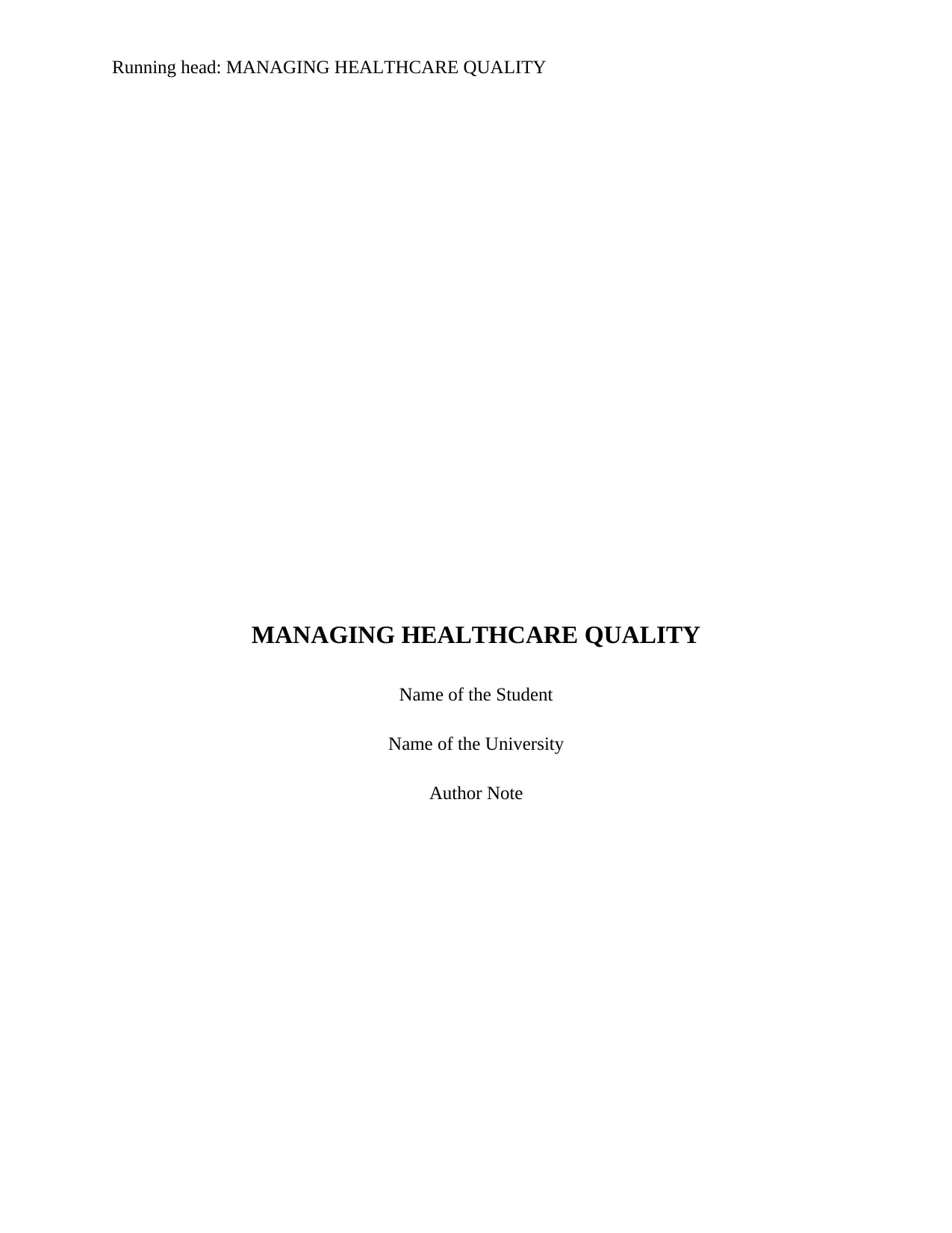
Running head: MANAGING HEALTHCARE QUALITY
MANAGING HEALTHCARE QUALITY
Name of the Student
Name of the University
Author Note
MANAGING HEALTHCARE QUALITY
Name of the Student
Name of the University
Author Note
Paraphrase This Document
Need a fresh take? Get an instant paraphrase of this document with our AI Paraphraser
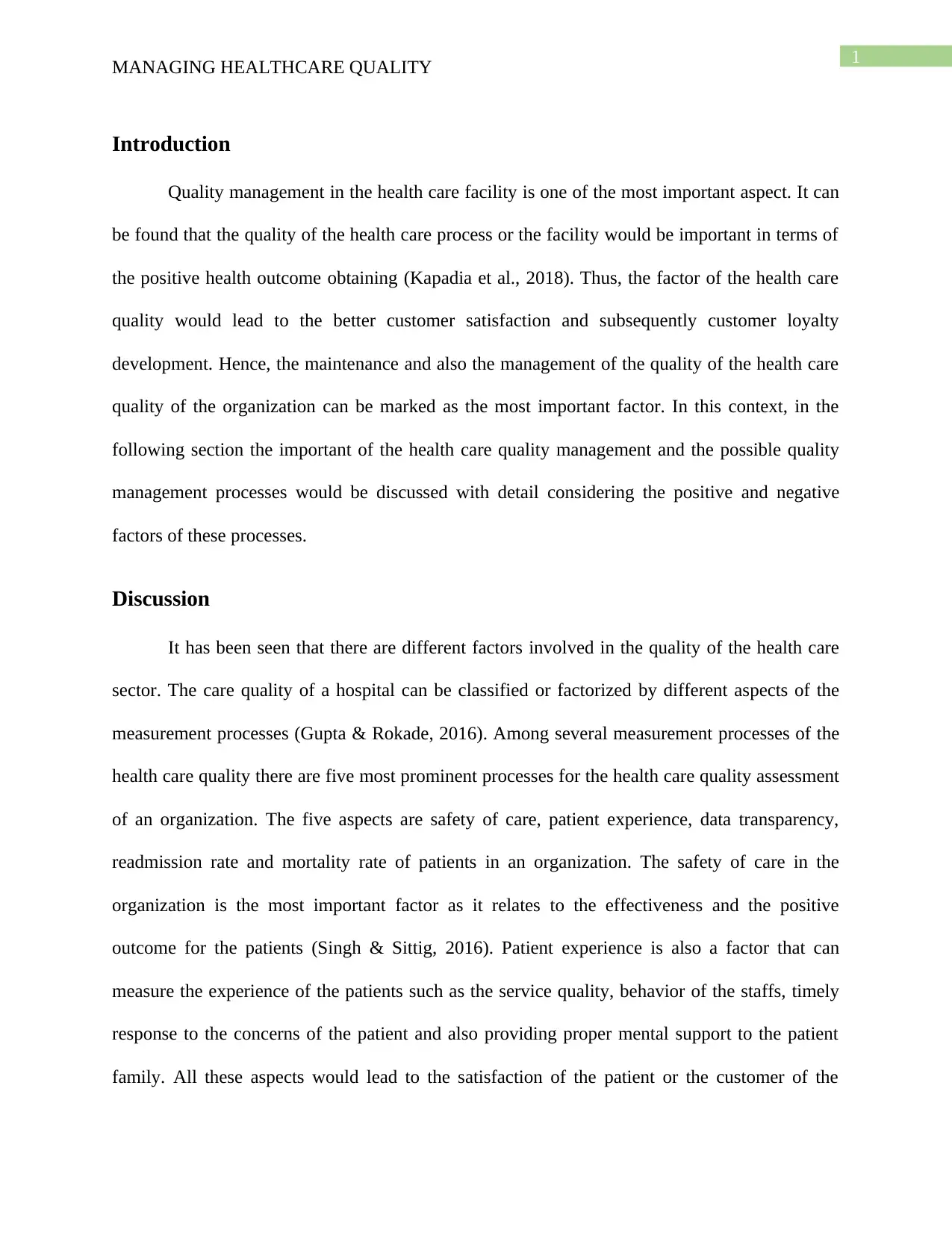
1
MANAGING HEALTHCARE QUALITY
Introduction
Quality management in the health care facility is one of the most important aspect. It can
be found that the quality of the health care process or the facility would be important in terms of
the positive health outcome obtaining (Kapadia et al., 2018). Thus, the factor of the health care
quality would lead to the better customer satisfaction and subsequently customer loyalty
development. Hence, the maintenance and also the management of the quality of the health care
quality of the organization can be marked as the most important factor. In this context, in the
following section the important of the health care quality management and the possible quality
management processes would be discussed with detail considering the positive and negative
factors of these processes.
Discussion
It has been seen that there are different factors involved in the quality of the health care
sector. The care quality of a hospital can be classified or factorized by different aspects of the
measurement processes (Gupta & Rokade, 2016). Among several measurement processes of the
health care quality there are five most prominent processes for the health care quality assessment
of an organization. The five aspects are safety of care, patient experience, data transparency,
readmission rate and mortality rate of patients in an organization. The safety of care in the
organization is the most important factor as it relates to the effectiveness and the positive
outcome for the patients (Singh & Sittig, 2016). Patient experience is also a factor that can
measure the experience of the patients such as the service quality, behavior of the staffs, timely
response to the concerns of the patient and also providing proper mental support to the patient
family. All these aspects would lead to the satisfaction of the patient or the customer of the
MANAGING HEALTHCARE QUALITY
Introduction
Quality management in the health care facility is one of the most important aspect. It can
be found that the quality of the health care process or the facility would be important in terms of
the positive health outcome obtaining (Kapadia et al., 2018). Thus, the factor of the health care
quality would lead to the better customer satisfaction and subsequently customer loyalty
development. Hence, the maintenance and also the management of the quality of the health care
quality of the organization can be marked as the most important factor. In this context, in the
following section the important of the health care quality management and the possible quality
management processes would be discussed with detail considering the positive and negative
factors of these processes.
Discussion
It has been seen that there are different factors involved in the quality of the health care
sector. The care quality of a hospital can be classified or factorized by different aspects of the
measurement processes (Gupta & Rokade, 2016). Among several measurement processes of the
health care quality there are five most prominent processes for the health care quality assessment
of an organization. The five aspects are safety of care, patient experience, data transparency,
readmission rate and mortality rate of patients in an organization. The safety of care in the
organization is the most important factor as it relates to the effectiveness and the positive
outcome for the patients (Singh & Sittig, 2016). Patient experience is also a factor that can
measure the experience of the patients such as the service quality, behavior of the staffs, timely
response to the concerns of the patient and also providing proper mental support to the patient
family. All these aspects would lead to the satisfaction of the patient or the customer of the
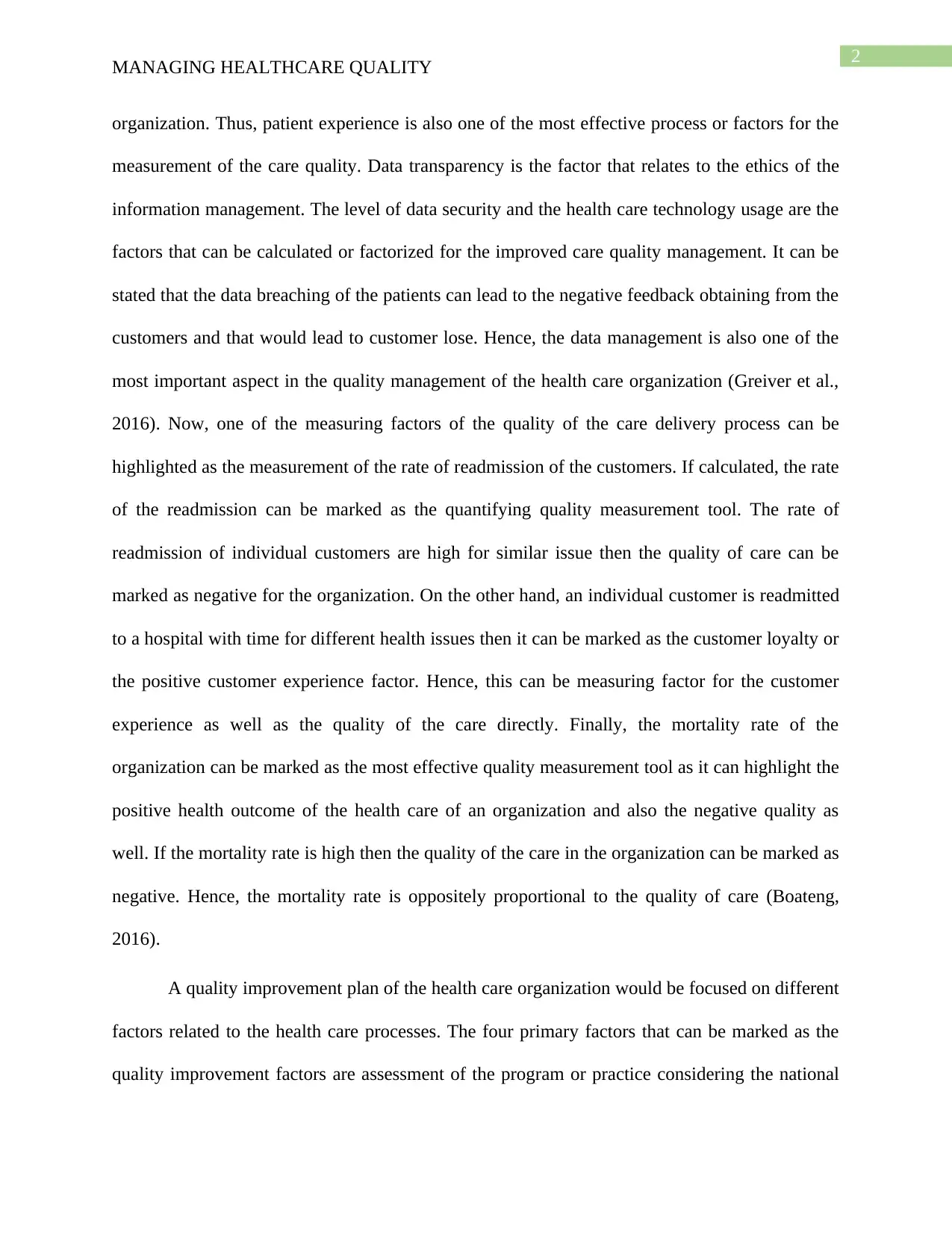
2
MANAGING HEALTHCARE QUALITY
organization. Thus, patient experience is also one of the most effective process or factors for the
measurement of the care quality. Data transparency is the factor that relates to the ethics of the
information management. The level of data security and the health care technology usage are the
factors that can be calculated or factorized for the improved care quality management. It can be
stated that the data breaching of the patients can lead to the negative feedback obtaining from the
customers and that would lead to customer lose. Hence, the data management is also one of the
most important aspect in the quality management of the health care organization (Greiver et al.,
2016). Now, one of the measuring factors of the quality of the care delivery process can be
highlighted as the measurement of the rate of readmission of the customers. If calculated, the rate
of the readmission can be marked as the quantifying quality measurement tool. The rate of
readmission of individual customers are high for similar issue then the quality of care can be
marked as negative for the organization. On the other hand, an individual customer is readmitted
to a hospital with time for different health issues then it can be marked as the customer loyalty or
the positive customer experience factor. Hence, this can be measuring factor for the customer
experience as well as the quality of the care directly. Finally, the mortality rate of the
organization can be marked as the most effective quality measurement tool as it can highlight the
positive health outcome of the health care of an organization and also the negative quality as
well. If the mortality rate is high then the quality of the care in the organization can be marked as
negative. Hence, the mortality rate is oppositely proportional to the quality of care (Boateng,
2016).
A quality improvement plan of the health care organization would be focused on different
factors related to the health care processes. The four primary factors that can be marked as the
quality improvement factors are assessment of the program or practice considering the national
MANAGING HEALTHCARE QUALITY
organization. Thus, patient experience is also one of the most effective process or factors for the
measurement of the care quality. Data transparency is the factor that relates to the ethics of the
information management. The level of data security and the health care technology usage are the
factors that can be calculated or factorized for the improved care quality management. It can be
stated that the data breaching of the patients can lead to the negative feedback obtaining from the
customers and that would lead to customer lose. Hence, the data management is also one of the
most important aspect in the quality management of the health care organization (Greiver et al.,
2016). Now, one of the measuring factors of the quality of the care delivery process can be
highlighted as the measurement of the rate of readmission of the customers. If calculated, the rate
of the readmission can be marked as the quantifying quality measurement tool. The rate of
readmission of individual customers are high for similar issue then the quality of care can be
marked as negative for the organization. On the other hand, an individual customer is readmitted
to a hospital with time for different health issues then it can be marked as the customer loyalty or
the positive customer experience factor. Hence, this can be measuring factor for the customer
experience as well as the quality of the care directly. Finally, the mortality rate of the
organization can be marked as the most effective quality measurement tool as it can highlight the
positive health outcome of the health care of an organization and also the negative quality as
well. If the mortality rate is high then the quality of the care in the organization can be marked as
negative. Hence, the mortality rate is oppositely proportional to the quality of care (Boateng,
2016).
A quality improvement plan of the health care organization would be focused on different
factors related to the health care processes. The four primary factors that can be marked as the
quality improvement factors are assessment of the program or practice considering the national
⊘ This is a preview!⊘
Do you want full access?
Subscribe today to unlock all pages.

Trusted by 1+ million students worldwide
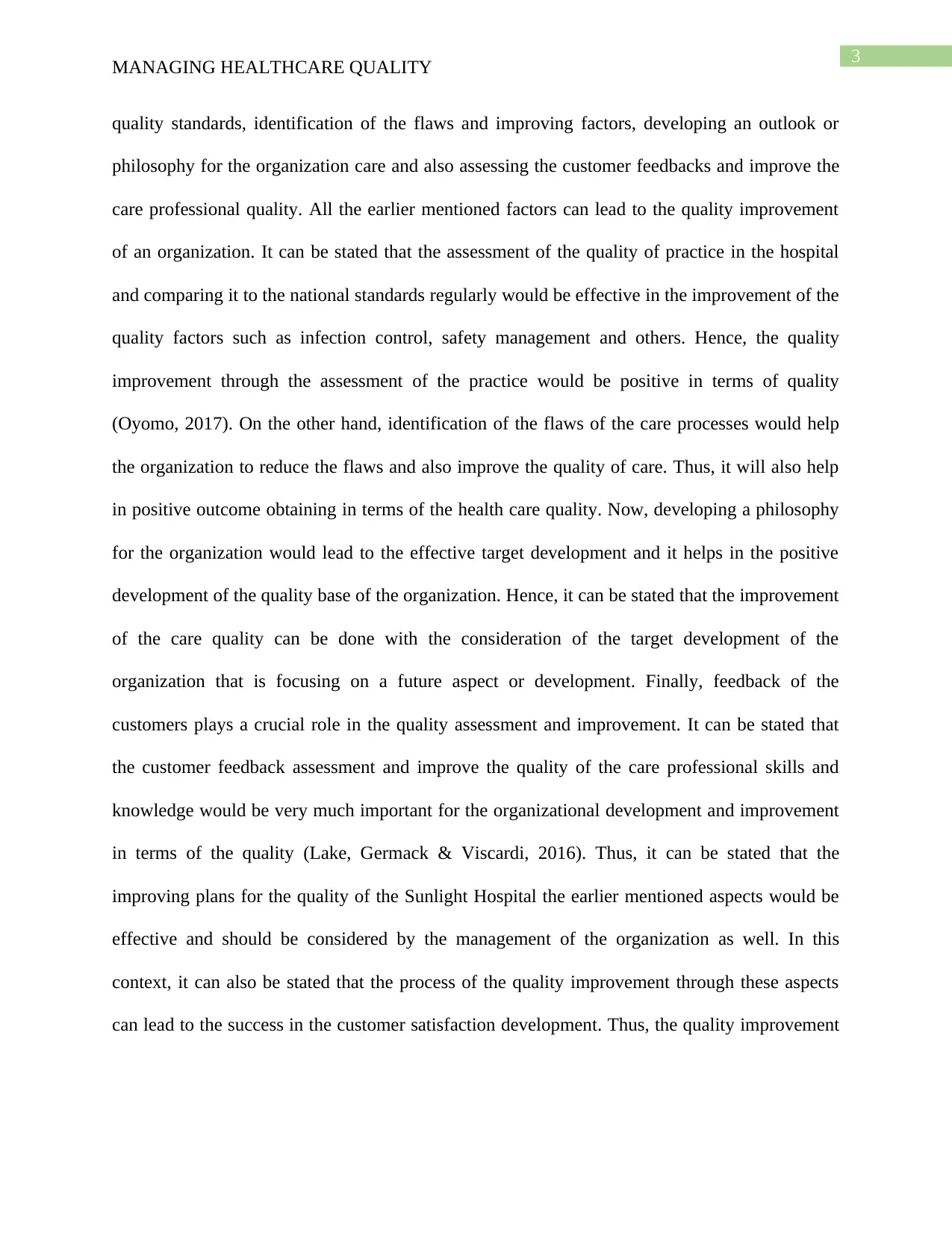
3
MANAGING HEALTHCARE QUALITY
quality standards, identification of the flaws and improving factors, developing an outlook or
philosophy for the organization care and also assessing the customer feedbacks and improve the
care professional quality. All the earlier mentioned factors can lead to the quality improvement
of an organization. It can be stated that the assessment of the quality of practice in the hospital
and comparing it to the national standards regularly would be effective in the improvement of the
quality factors such as infection control, safety management and others. Hence, the quality
improvement through the assessment of the practice would be positive in terms of quality
(Oyomo, 2017). On the other hand, identification of the flaws of the care processes would help
the organization to reduce the flaws and also improve the quality of care. Thus, it will also help
in positive outcome obtaining in terms of the health care quality. Now, developing a philosophy
for the organization would lead to the effective target development and it helps in the positive
development of the quality base of the organization. Hence, it can be stated that the improvement
of the care quality can be done with the consideration of the target development of the
organization that is focusing on a future aspect or development. Finally, feedback of the
customers plays a crucial role in the quality assessment and improvement. It can be stated that
the customer feedback assessment and improve the quality of the care professional skills and
knowledge would be very much important for the organizational development and improvement
in terms of the quality (Lake, Germack & Viscardi, 2016). Thus, it can be stated that the
improving plans for the quality of the Sunlight Hospital the earlier mentioned aspects would be
effective and should be considered by the management of the organization as well. In this
context, it can also be stated that the process of the quality improvement through these aspects
can lead to the success in the customer satisfaction development. Thus, the quality improvement
MANAGING HEALTHCARE QUALITY
quality standards, identification of the flaws and improving factors, developing an outlook or
philosophy for the organization care and also assessing the customer feedbacks and improve the
care professional quality. All the earlier mentioned factors can lead to the quality improvement
of an organization. It can be stated that the assessment of the quality of practice in the hospital
and comparing it to the national standards regularly would be effective in the improvement of the
quality factors such as infection control, safety management and others. Hence, the quality
improvement through the assessment of the practice would be positive in terms of quality
(Oyomo, 2017). On the other hand, identification of the flaws of the care processes would help
the organization to reduce the flaws and also improve the quality of care. Thus, it will also help
in positive outcome obtaining in terms of the health care quality. Now, developing a philosophy
for the organization would lead to the effective target development and it helps in the positive
development of the quality base of the organization. Hence, it can be stated that the improvement
of the care quality can be done with the consideration of the target development of the
organization that is focusing on a future aspect or development. Finally, feedback of the
customers plays a crucial role in the quality assessment and improvement. It can be stated that
the customer feedback assessment and improve the quality of the care professional skills and
knowledge would be very much important for the organizational development and improvement
in terms of the quality (Lake, Germack & Viscardi, 2016). Thus, it can be stated that the
improving plans for the quality of the Sunlight Hospital the earlier mentioned aspects would be
effective and should be considered by the management of the organization as well. In this
context, it can also be stated that the process of the quality improvement through these aspects
can lead to the success in the customer satisfaction development. Thus, the quality improvement
Paraphrase This Document
Need a fresh take? Get an instant paraphrase of this document with our AI Paraphraser
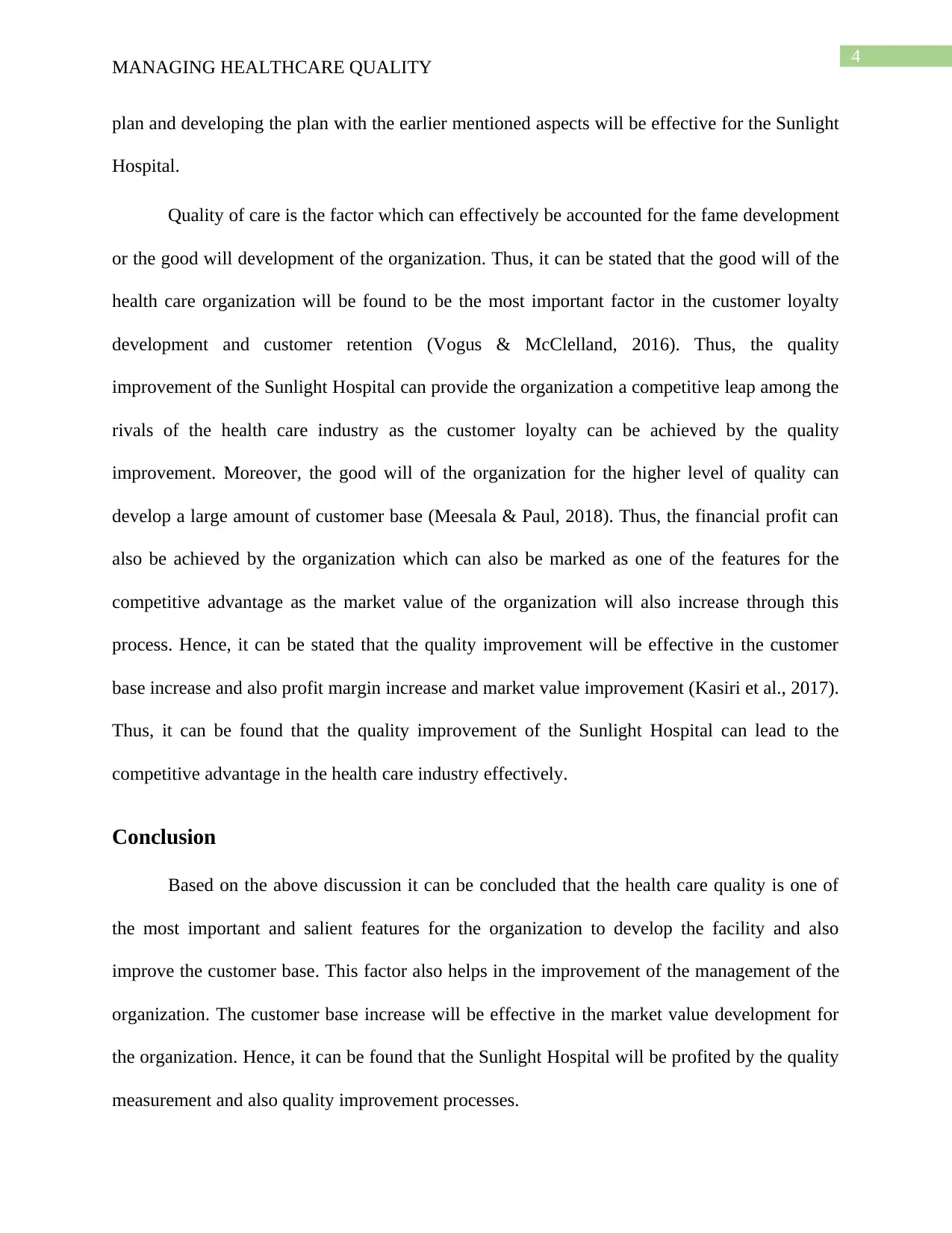
4
MANAGING HEALTHCARE QUALITY
plan and developing the plan with the earlier mentioned aspects will be effective for the Sunlight
Hospital.
Quality of care is the factor which can effectively be accounted for the fame development
or the good will development of the organization. Thus, it can be stated that the good will of the
health care organization will be found to be the most important factor in the customer loyalty
development and customer retention (Vogus & McClelland, 2016). Thus, the quality
improvement of the Sunlight Hospital can provide the organization a competitive leap among the
rivals of the health care industry as the customer loyalty can be achieved by the quality
improvement. Moreover, the good will of the organization for the higher level of quality can
develop a large amount of customer base (Meesala & Paul, 2018). Thus, the financial profit can
also be achieved by the organization which can also be marked as one of the features for the
competitive advantage as the market value of the organization will also increase through this
process. Hence, it can be stated that the quality improvement will be effective in the customer
base increase and also profit margin increase and market value improvement (Kasiri et al., 2017).
Thus, it can be found that the quality improvement of the Sunlight Hospital can lead to the
competitive advantage in the health care industry effectively.
Conclusion
Based on the above discussion it can be concluded that the health care quality is one of
the most important and salient features for the organization to develop the facility and also
improve the customer base. This factor also helps in the improvement of the management of the
organization. The customer base increase will be effective in the market value development for
the organization. Hence, it can be found that the Sunlight Hospital will be profited by the quality
measurement and also quality improvement processes.
MANAGING HEALTHCARE QUALITY
plan and developing the plan with the earlier mentioned aspects will be effective for the Sunlight
Hospital.
Quality of care is the factor which can effectively be accounted for the fame development
or the good will development of the organization. Thus, it can be stated that the good will of the
health care organization will be found to be the most important factor in the customer loyalty
development and customer retention (Vogus & McClelland, 2016). Thus, the quality
improvement of the Sunlight Hospital can provide the organization a competitive leap among the
rivals of the health care industry as the customer loyalty can be achieved by the quality
improvement. Moreover, the good will of the organization for the higher level of quality can
develop a large amount of customer base (Meesala & Paul, 2018). Thus, the financial profit can
also be achieved by the organization which can also be marked as one of the features for the
competitive advantage as the market value of the organization will also increase through this
process. Hence, it can be stated that the quality improvement will be effective in the customer
base increase and also profit margin increase and market value improvement (Kasiri et al., 2017).
Thus, it can be found that the quality improvement of the Sunlight Hospital can lead to the
competitive advantage in the health care industry effectively.
Conclusion
Based on the above discussion it can be concluded that the health care quality is one of
the most important and salient features for the organization to develop the facility and also
improve the customer base. This factor also helps in the improvement of the management of the
organization. The customer base increase will be effective in the market value development for
the organization. Hence, it can be found that the Sunlight Hospital will be profited by the quality
measurement and also quality improvement processes.

5
MANAGING HEALTHCARE QUALITY
MANAGING HEALTHCARE QUALITY
⊘ This is a preview!⊘
Do you want full access?
Subscribe today to unlock all pages.

Trusted by 1+ million students worldwide
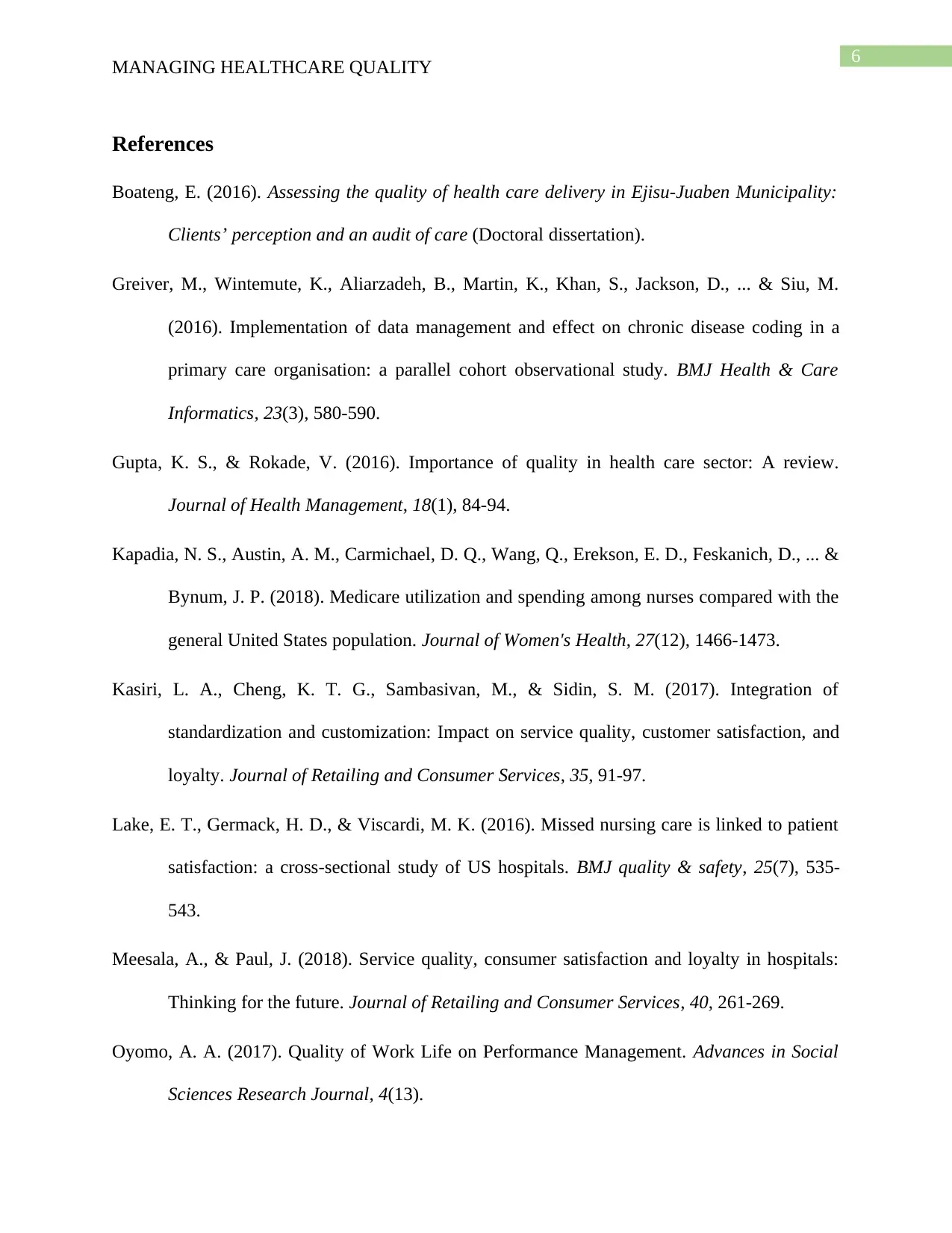
6
MANAGING HEALTHCARE QUALITY
References
Boateng, E. (2016). Assessing the quality of health care delivery in Ejisu-Juaben Municipality:
Clients’ perception and an audit of care (Doctoral dissertation).
Greiver, M., Wintemute, K., Aliarzadeh, B., Martin, K., Khan, S., Jackson, D., ... & Siu, M.
(2016). Implementation of data management and effect on chronic disease coding in a
primary care organisation: a parallel cohort observational study. BMJ Health & Care
Informatics, 23(3), 580-590.
Gupta, K. S., & Rokade, V. (2016). Importance of quality in health care sector: A review.
Journal of Health Management, 18(1), 84-94.
Kapadia, N. S., Austin, A. M., Carmichael, D. Q., Wang, Q., Erekson, E. D., Feskanich, D., ... &
Bynum, J. P. (2018). Medicare utilization and spending among nurses compared with the
general United States population. Journal of Women's Health, 27(12), 1466-1473.
Kasiri, L. A., Cheng, K. T. G., Sambasivan, M., & Sidin, S. M. (2017). Integration of
standardization and customization: Impact on service quality, customer satisfaction, and
loyalty. Journal of Retailing and Consumer Services, 35, 91-97.
Lake, E. T., Germack, H. D., & Viscardi, M. K. (2016). Missed nursing care is linked to patient
satisfaction: a cross-sectional study of US hospitals. BMJ quality & safety, 25(7), 535-
543.
Meesala, A., & Paul, J. (2018). Service quality, consumer satisfaction and loyalty in hospitals:
Thinking for the future. Journal of Retailing and Consumer Services, 40, 261-269.
Oyomo, A. A. (2017). Quality of Work Life on Performance Management. Advances in Social
Sciences Research Journal, 4(13).
MANAGING HEALTHCARE QUALITY
References
Boateng, E. (2016). Assessing the quality of health care delivery in Ejisu-Juaben Municipality:
Clients’ perception and an audit of care (Doctoral dissertation).
Greiver, M., Wintemute, K., Aliarzadeh, B., Martin, K., Khan, S., Jackson, D., ... & Siu, M.
(2016). Implementation of data management and effect on chronic disease coding in a
primary care organisation: a parallel cohort observational study. BMJ Health & Care
Informatics, 23(3), 580-590.
Gupta, K. S., & Rokade, V. (2016). Importance of quality in health care sector: A review.
Journal of Health Management, 18(1), 84-94.
Kapadia, N. S., Austin, A. M., Carmichael, D. Q., Wang, Q., Erekson, E. D., Feskanich, D., ... &
Bynum, J. P. (2018). Medicare utilization and spending among nurses compared with the
general United States population. Journal of Women's Health, 27(12), 1466-1473.
Kasiri, L. A., Cheng, K. T. G., Sambasivan, M., & Sidin, S. M. (2017). Integration of
standardization and customization: Impact on service quality, customer satisfaction, and
loyalty. Journal of Retailing and Consumer Services, 35, 91-97.
Lake, E. T., Germack, H. D., & Viscardi, M. K. (2016). Missed nursing care is linked to patient
satisfaction: a cross-sectional study of US hospitals. BMJ quality & safety, 25(7), 535-
543.
Meesala, A., & Paul, J. (2018). Service quality, consumer satisfaction and loyalty in hospitals:
Thinking for the future. Journal of Retailing and Consumer Services, 40, 261-269.
Oyomo, A. A. (2017). Quality of Work Life on Performance Management. Advances in Social
Sciences Research Journal, 4(13).
Paraphrase This Document
Need a fresh take? Get an instant paraphrase of this document with our AI Paraphraser
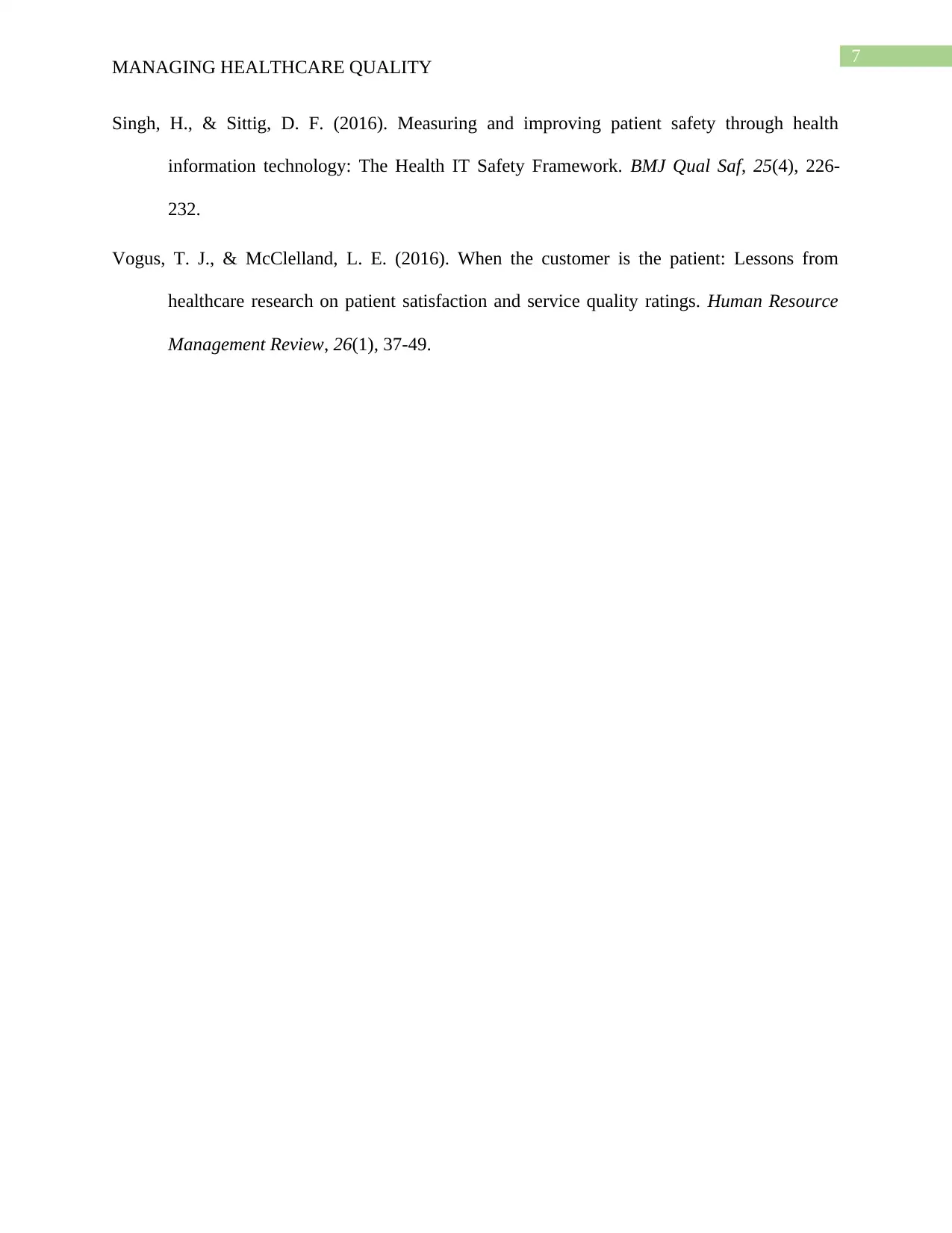
7
MANAGING HEALTHCARE QUALITY
Singh, H., & Sittig, D. F. (2016). Measuring and improving patient safety through health
information technology: The Health IT Safety Framework. BMJ Qual Saf, 25(4), 226-
232.
Vogus, T. J., & McClelland, L. E. (2016). When the customer is the patient: Lessons from
healthcare research on patient satisfaction and service quality ratings. Human Resource
Management Review, 26(1), 37-49.
MANAGING HEALTHCARE QUALITY
Singh, H., & Sittig, D. F. (2016). Measuring and improving patient safety through health
information technology: The Health IT Safety Framework. BMJ Qual Saf, 25(4), 226-
232.
Vogus, T. J., & McClelland, L. E. (2016). When the customer is the patient: Lessons from
healthcare research on patient satisfaction and service quality ratings. Human Resource
Management Review, 26(1), 37-49.
1 out of 8
Related Documents
Your All-in-One AI-Powered Toolkit for Academic Success.
+13062052269
info@desklib.com
Available 24*7 on WhatsApp / Email
![[object Object]](/_next/static/media/star-bottom.7253800d.svg)
Unlock your academic potential
Copyright © 2020–2025 A2Z Services. All Rights Reserved. Developed and managed by ZUCOL.





